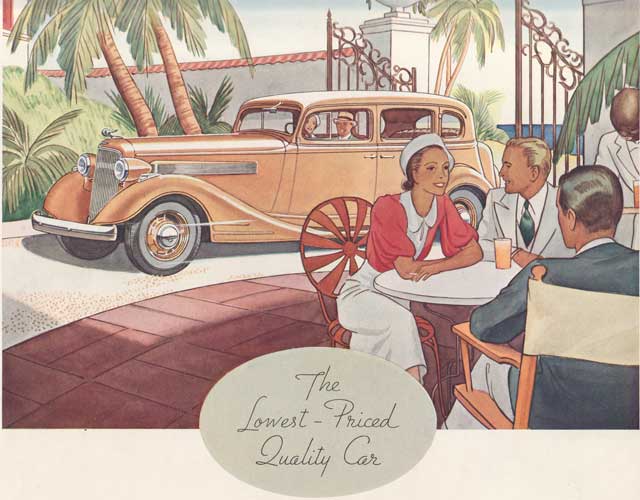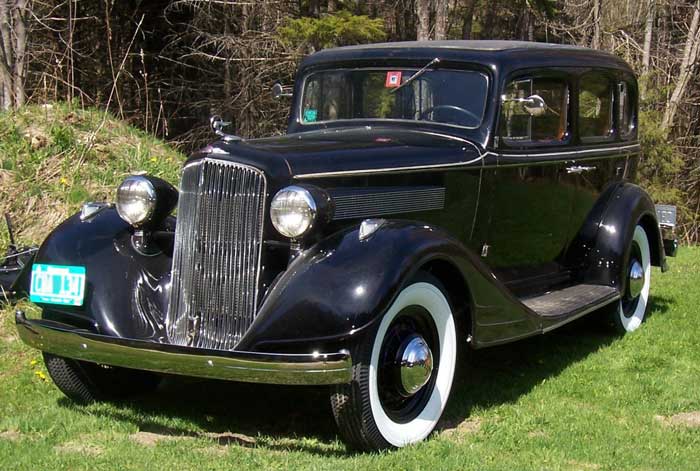
1934 Pontiac
The Pontiac line for 1934 featured larger Fisher bodies as compared with the previous year, along with a completely new chassis riding on a 117" wheelbase. The big news this year was the new "knee-action" independent front suspension of the Dubonnet type. The Dubonnet system was completely self-contained with the coil spring and double acting shock absorber carried in an oil-filled housing. There was a unit for each front wheel, the housings were mounted to the chassis and each spindle was carried on links that allowed for the necessary suspension movement. The housings were mounted so they rotated and the steering linkage connected to them, not the spindles. This feature, called True Course Steering allowed for much smoother steering action since the linkage was not connected directly to a potentially bouncing wheel. The Pontiac frame was all new due to the "knee action" suspension and its cross members appeared to form the letters K and Y, hence the name K-Y frame. The rear suspension was equipped with a stabilizer bar connected to the shock absorber links and minimized body roll on turns. A small but important change was the installation of Zerk type grease fittings on the chassis, these fittings allowed grease to be injected with up to 10,000 pounds of pressure, insuring that the grease was forced into the tightest clearances. Bendix cable actuated brakes were fitted; and the parking brake functioned on all 4 wheels. All models were fitted with 6.00 x 17 low pressure tires mounted on 48 spoke wire wheels. The standard axle ratio was 4.55:1 and the driveshaft was partially enclosed in a torque tube.
This was only the second model year for the straight eight engine and it was already being improved upon. A new G.M.R. cylinder head was installed that raised the compression ratio from 5.7 to 6.2:1. The head featured bosses in place over each of the valves that raised the compression without interfering with airflow in and out of the combustion chamber. The horsepower rating was now 84 @ 3,800 rpm, up 7 from the previous model year. In addition to the increased compression, the distributor was fitted with both an octane selector and the "Vacuumatic" spark control unit for increased performance and fuel economy. The octane selector provided a measured scale that allowed the driver to easily advance or retard the base ignition timing to adjust for higher octane fuels that were becoming more readily available. Another important change was the improved intake manifold heater that utilized a thin steel tube to quickly warm the incoming fuel mixture. This feature minimized the use of the choke and offered improved cold weather performance. Despite the fact that the new bodies were heavier than the '33 models, and that the engine had increased horsepower, the '34 Pontiacs got 10% better fuel economy than they had the previous year.
The Pontiac line for 1934 featured larger Fisher bodies as compared with the previous year, along with a completely new chassis riding on a 117" wheelbase. The big news this year was the new "knee-action" independent front suspension of the Dubonnet type. The Dubonnet system was completely self-contained with the coil spring and double acting shock absorber carried in an oil-filled housing. There was a unit for each front wheel, the housings were mounted to the chassis and each spindle was carried on links that allowed for the necessary suspension movement. The housings were mounted so they rotated and the steering linkage connected to them, not the spindles. This feature, called True Course Steering allowed for much smoother steering action since the linkage was not connected directly to a potentially bouncing wheel. The Pontiac frame was all new due to the "knee action" suspension and its cross members appeared to form the letters K and Y, hence the name K-Y frame. The rear suspension was equipped with a stabilizer bar connected to the shock absorber links and minimized body roll on turns. A small but important change was the installation of Zerk type grease fittings on the chassis, these fittings allowed grease to be injected with up to 10,000 pounds of pressure, insuring that the grease was forced into the tightest clearances. Bendix cable actuated brakes were fitted; and the parking brake functioned on all 4 wheels. All models were fitted with 6.00 x 17 low pressure tires mounted on 48 spoke wire wheels. The standard axle ratio was 4.55:1 and the driveshaft was partially enclosed in a torque tube.
This was only the second model year for the straight eight engine and it was already being improved upon. A new G.M.R. cylinder head was installed that raised the compression ratio from 5.7 to 6.2:1. The head featured bosses in place over each of the valves that raised the compression without interfering with airflow in and out of the combustion chamber. The horsepower rating was now 84 @ 3,800 rpm, up 7 from the previous model year. In addition to the increased compression, the distributor was fitted with both an octane selector and the "Vacuumatic" spark control unit for increased performance and fuel economy. The octane selector provided a measured scale that allowed the driver to easily advance or retard the base ignition timing to adjust for higher octane fuels that were becoming more readily available. Another important change was the improved intake manifold heater that utilized a thin steel tube to quickly warm the incoming fuel mixture. This feature minimized the use of the choke and offered improved cold weather performance. Despite the fact that the new bodies were heavier than the '33 models, and that the engine had increased horsepower, the '34 Pontiacs got 10% better fuel economy than they had the previous year.
Pontiac offered 7 models to choose from in 1934 beginning with a 2 door, 2 passenger coupe (3 window); a 2 door Sport coupe with rumble seat (5 window); a 2 door cabriolet with rumble seat; a 2 door, 5 passenger sedan; and a 4 door, 5 passenger sedan. In addition, there were both a 2 door and a 4 door Touring sedan with trunk available. An optional metal trunk was available for the 2 or 4 door sedan which was very similar in appearance to the Touring sedan body. All models were standard with 5 wheel equipment, the spare tire being mounted on the rear body. A single side mount spare was available, with or without a trunk rack. When 6 wheel equipment was ordered, than the spares were carried in dual side mounts and a trunk rack was fitted to the rear body. All ’34 models were standard with safety glass in the windshield and all ventilator windows; side window safety glass was available as an extra cost option on all models. The sales literature was shown in color but no colors were mentioned, current color information was available at any Pontiac zone office. Fenders were black enamel as standard equipment; Duco to harmonize with the body color was available for $10.
Fisher No-draft Ventilation was standard on all models with some improvements; the front vent windows were larger and the cowl ventilator opened to the rear against the high pressure area at the base of the windshield. The 4 door sedans had vent panes fitted to the rear quarter windows for additional comfort of the rear seat passengers. The all new bodies offered more interior room than any other automobile in the low priced field. Upholstery was either mohair or cloth on all closed models; the cabriolet was available with leather or cloth. The dashboard was finished with a walnut appearance; a central panel carried all control knobs plus the ignition switch. New for 1934 was the Starterator, which combined the starter with the accelerator; a vacuum switch prevented starter engagement once the engine was running.
The ’34 Pontiac offered tremendous value in the marketplace; a large, eight cylinder automobile at a price less than many competing six cylinder jobs. Many of the Pontiac engineering features wouldn’t appear on other makes for years to come, if at all. There were many straight eight engines available in 1934, but none of them as inexpensive as the Pontiac, which probably explains why 78,859 were produced.
Fisher No-draft Ventilation was standard on all models with some improvements; the front vent windows were larger and the cowl ventilator opened to the rear against the high pressure area at the base of the windshield. The 4 door sedans had vent panes fitted to the rear quarter windows for additional comfort of the rear seat passengers. The all new bodies offered more interior room than any other automobile in the low priced field. Upholstery was either mohair or cloth on all closed models; the cabriolet was available with leather or cloth. The dashboard was finished with a walnut appearance; a central panel carried all control knobs plus the ignition switch. New for 1934 was the Starterator, which combined the starter with the accelerator; a vacuum switch prevented starter engagement once the engine was running.
The ’34 Pontiac offered tremendous value in the marketplace; a large, eight cylinder automobile at a price less than many competing six cylinder jobs. Many of the Pontiac engineering features wouldn’t appear on other makes for years to come, if at all. There were many straight eight engines available in 1934, but none of them as inexpensive as the Pontiac, which probably explains why 78,859 were produced.
Magazine Ad Links: Bigger Smoother Finer A Joy to Own Pack up Your Troubles Park with Pride
Pontiac Owner Straight Eight Power Biggest Value for Every Dollar Outstanding Features
Pontiac Owner Straight Eight Power Biggest Value for Every Dollar Outstanding Features


'34 owned by Huck & Sally Mundell
